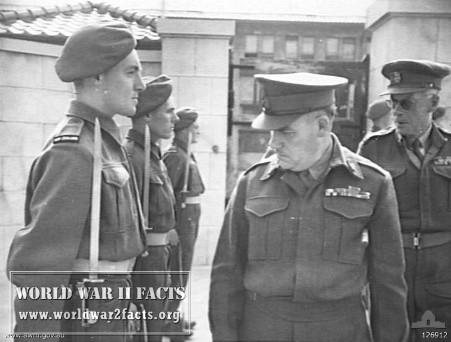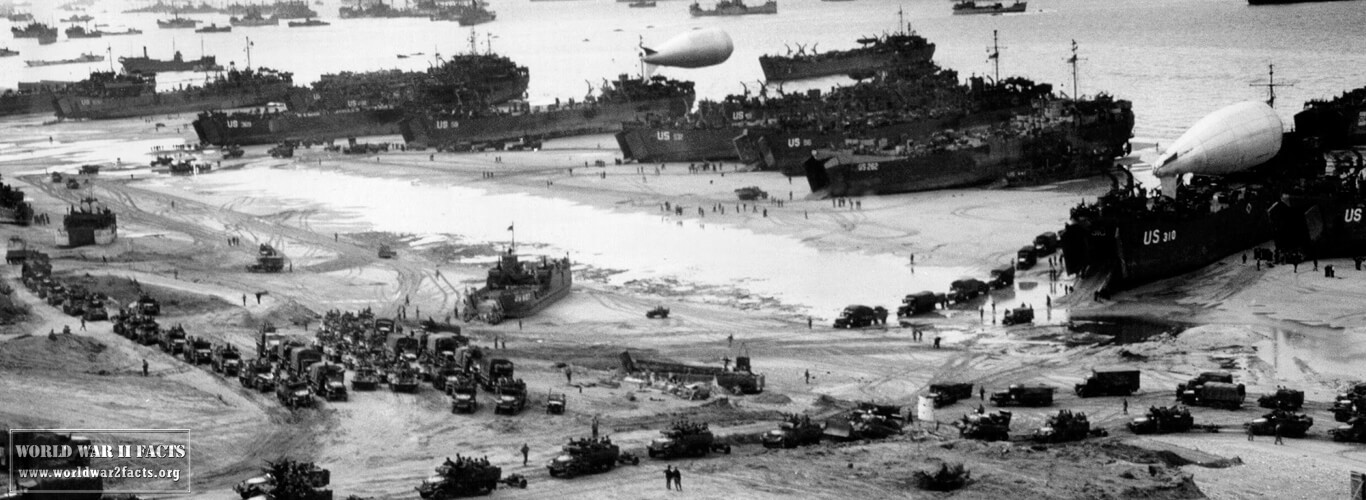WW2 Army Units and Sizes
 In Japan, Lieutenant General J. Northcott CB MVO, Commander In Chief, British Commonwealth Occupation Force (BCOF), inspects the guard of honour at HQ 9th New Zealand Infantry Brigade ; April 17th 1946.
In Japan, Lieutenant General J. Northcott CB MVO, Commander In Chief, British Commonwealth Occupation Force (BCOF), inspects the guard of honour at HQ 9th New Zealand Infantry Brigade ; April 17th 1946.When studying World War 2, a common question is what precisely each army group or unit name means. This question arises a fair bit with readers of WorldWar2Facts.org, so we have compiled a table to help explain what the unit or group names mean, what units made up larger WW2 army units, the rough size of the unit, and what rank of officer or NCO was generally in charge.
Depending on the country, the specific rank or number of personnel may have been different during the war; however, this table should provide the reader with the proper context to continue his or her studies of the war. The numbers provided are roughly based on the notional sizes for infantry units. For mechanized or support units, there will be a bit more variation in the total numbers within the group. Additionally, although we use the term “army” in this table, the Marines use a similar hierarchy with mainly the same names as the Army to study the war.
WW2 Army Unit and Size Composition Table
Contents
The hierarchy of World War II army unit size and composition varied somewhat between the different countries involved in the war, but the general structure of most armies was similar. Here is a general hierarchy of the most common army units in descending order of size:
| Army Unit Name | Military Group/Unit Composition | Approximate Number of Personnel: | Normally Commanded by: |
|---|---|---|---|
| Army | 2 or more Corps | 100,000 to 150,000+ | General or Field Marshal |
| Corps | 2 or more Divisions | 25,000 to 50,000 | General or Lt. General |
| Division | 3 or more Brigades or Regiments, depending on the country. | 10,000 to 15,000 | Lieutenant. General or Major General |
| Brigade | 3 or more Battalions | 1500 to 3500 | Major General, Brigadier General,
or Colonel |
| Regiment | 2 or more Battalions | 1000 to 2000 | Colonel |
| Battalion | 3 or more Companies | 400 to 1000 | Lt. Cololonel |
| Company | 2 or more Platoons | 100 to 250 | Captain or Major |
| Platoon / Troop | 2 or more Squads | 16 to 50 | 1st Lt. |
| Squad | 2 or more Sections | 8 to 24 | Sergeant (Sgt) |
| Section / Fire Team | 4 to 12 | Sergeant or Corporal |
- Army – An army was the largest formation of troops, consisting of two or more corps, and was commanded by a general. The size of an army could range from 100,000 to several hundred thousand soldiers.
- Corps – A corps comprised two or more divisions and was commanded by a lieutenant general. The size of a corps could range from 30,000 to 100,000 troops.
- Division – A division was typically made up of three regiments and support units and was commanded by a major general. The size of a division could range from 10,000 to 20,000 troops.
- Regiment – A regiment comprised three or more battalions and was commanded by a colonel. The size of a regiment could range from 1,000 to 5,000 troops.
- Battalion – A battalion comprised three or more companies and was commanded by a lieutenant colonel. The size of a battalion could range from 500 to 1,500 troops.
- Company – A company was made up of three or more platoons and was commanded by a captain. The size of a company could range from 100 to 250 troops.
- Platoon – A platoon consisted of three or more squads and was commanded by a lieutenant. The size of a platoon could range from 20 to 50 troops.
- Squad – A squad comprised 8-12 soldiers and was commanded by a sergeant.
What was the Most Common Army Group?
Across the Allied and Axis armies, the battalion is likely to be the most referred to Army or Marine group or unit when studying WW2. Many countries preferred having at least three groups that made up the next unit in the army hierarchy, with four being optimal.
These numbers allowed two to three groups to be placed on the front line or where the expected action would be and maintain one in reserve. Despite the advent of more modern communications and sensor technology since World War II, similar army group organization has been mostly adhered to in the modern day in conflicts such as Operations Enduring and Iraqi Freedom.

What Role did the Regiment have in World War 2?
Regiments have been a part of the military landscape since at least the 17th and 18th centuries when they were the primary organizational unit for an army. At this time, a regiment was notionally composed of 1,000 personnel and was commanded by a Colonel.
Fast forward to World War II, and we see a shift in how regiments were used. Many countries centralized the training, administration, and tactical employment of subordinate units composed of three or more battalions at the division level. This meant that the previously organized regiments were divided to form a division. This change in how regiments were used and organized impacted how the military is structured today.
During WW2, although many regimental organizations would be united to form a division, many countries chose to center the training, administration, and tactical employment of subordinate units at the division level consisting of three or more battalions.
What Role did the Task Force Play in WW2?
During World War 2, a Task Force was a temporary grouping of one or more units for a specific operation. Meant to be temporary in nature, the Task Force ideal was shared across the various militaries that took part in the war, albeit under slightly different names in some cases. For the Germans, the term was Kampfgruppe, and the Americans used the term U.S. Combat Team at times during the war.


